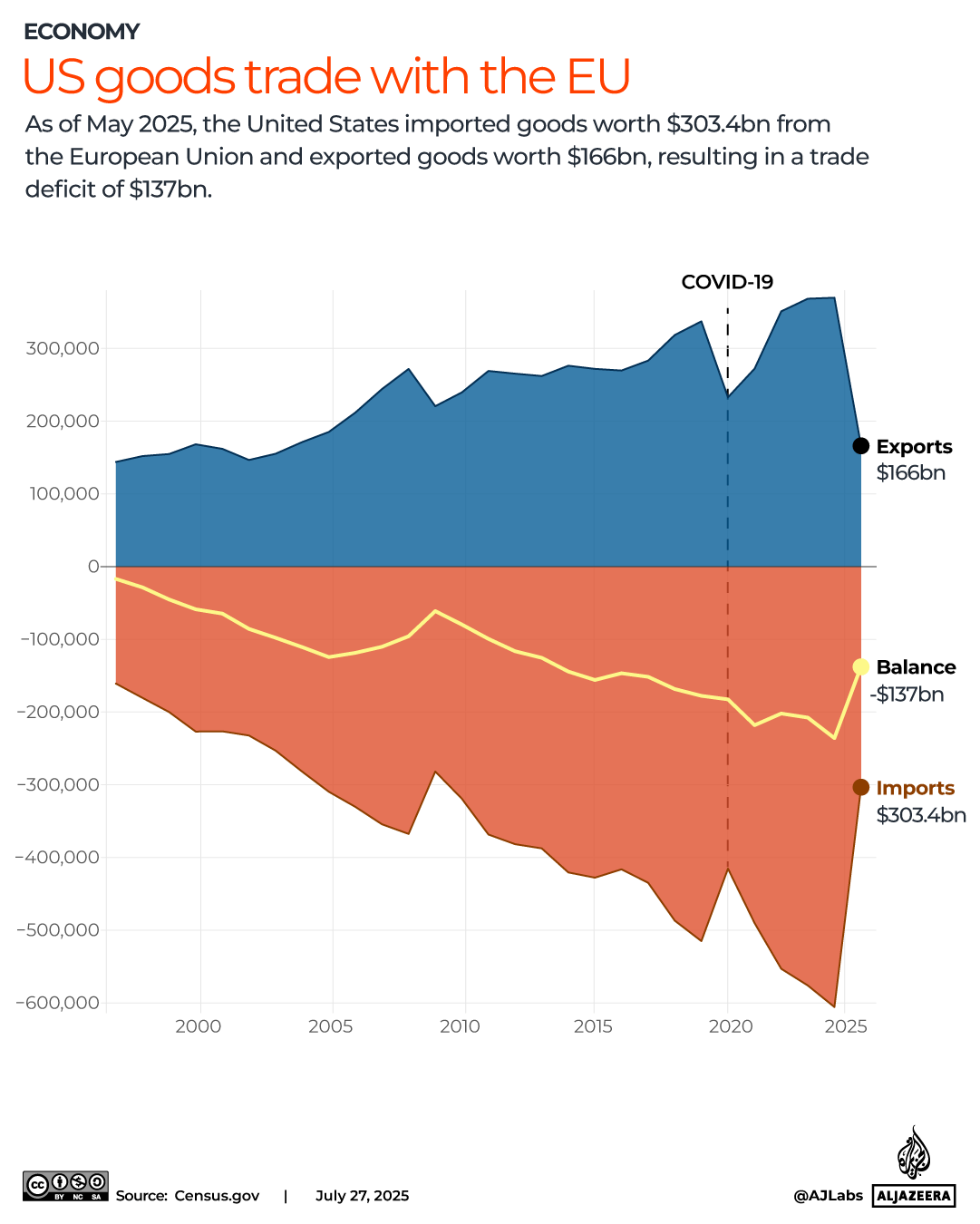After weeks of intensive trade talks between the two countries, as Brussels tries to reach a deal with Washington to prevent a transatlantic trade war, United States President Donald Trump is scheduled to hold crucial talks with European Union head Ursula von der Leyen in Scotland.
On Sunday, Von der Leyen, the president of the European Commission, will meet with the US president at his Scottish resort, Turnberry Golf Club. The meeting will likely lead to a deal, according to European ministers, to avoid Trump’s threat of 30% tariffs on EU goods.
Negotiators in Europe are aiming for tariffs to be set at 15%, according to those who are present. Trump claimed to the media on Friday that the bloc “wants] to make a deal very badly.”
If no agreement can be reached by Friday’s deadline, Trump threatened to impose the 30% tariffs on July 12. That would add to the already-applicable 25% tariffs on cars and auto parts and the 50% levies on steel and aluminum.
Trump has frequently targeted the EU, which is Washington’s largest trading partner, with the president accusing the bloc of “ripping off” the US.
In 2024, EU exports to the US totalled 532 billion euros , ($603bn). According to EU data, pharmaceuticals, automotive parts, and industrial chemicals accounted for the bulk of exports.
Will the Trump-von der Leyen meeting lead to a breakthrough and put an end to transatlantic trade tensions?
What distinguishes the two sides in particular?
There are “20 sticking points,” the US president told reporters at Turnberry on Friday.
When asked what they were, he responded, “Well, I don’t want to tell you what the sticking points are.”
He also described von der Leyen as a “highly respected woman” and predicted a “good” outcome for their Sunday meeting, giving a 50-50 chance of a deal.
If negotiations fail, a growing number of EU countries are reportedly asking Brussels to implement a retaliatory tariffs package that has already been developed on 90 billion euros ($109bn) of US goods, including car parts and bourbon.
Since April 9, when Trump paused what he calls his “reciprocal” tariffs, which he placed on nearly all nations, the two sides have been negotiating. In 2023, they traded 1.6 trillion euros ($1.8 trillion) in goods and services.
Since then, the US has levied a flat 10% sur all EU products, 25% on cars, and 50% on steel and aluminum.
EU Trade Commissioner Maros Sefcovic stated in this month that “we need to go for these rebalancing measures to protect the EU economy.”
The bloc’s trade policies, however, are reportedly fraught with disagreement. Other EU members, particularly France, have urged negotiators to avoid a stacked US-US deal, despite Germany’s demand for a quick deal to safeguard its industries.
According to von der Leyen spokesman Paula Pinho, intensive negotiations are taking place between the EU and the US on a technical and political level on Saturday. The scope for a balanced outcome that provides stability and predictability for both businesses and consumers on both sides of the Atlantic will now be taken into account by leaders.
What kind of business did the US and EU engage in?
The US-EU goods trade reached nearly $1 trillion in 2024, making the US the world’s largest trading partner.
The US purchased more goods overall for $ 235.6 billion than it did the EU’s 27 nations, or $ 235.6 billion. On the other hand, the US profited from trade with the EU in services.
US purchases totaling roughly $606 billion included pharmaceuticals, mechanical goods, cars, and other non-railway goods primarily from the EU.
US exports to the EU totaling $ 370 billion were made of fuel, pharmaceutical products, machinery, and aircraft.
Why have they been so unsuccessful in negotiating a deal?
Trump has long alleged that the EU is defrauding his country, just like the other countries that the US trades with. He is now demanding that Brussels reduce its goods trade surplus.
Washington has raised questions about the rules governing food exports and IT services in Europe in recent weeks. Trump has argued that these controls serve as nontariff trade barriers.
Sefcovic recently stated to the Financial Times that he wants to purchase more US gas, weapons, and farm products to reduce the US-EU trade deficit.
French President Emmanuel Macron stated on Wednesday that while European leaders want the lowest tariffs, they also “want to be respected as the partners that we are.”
Danish Foreign Minister Lars Lokke Rasmussen stated to reporters in Brussels on July 14 that “we should prepare to be ready to use all the tools.”
He continued, “You must prepare for war if you want peace.” The Scottish negotiators are hopeful that that won’t happen.
According to an economic forecasting firm called Oxford Economics, the EU could be “to the brink of recession” by the end of this month.
Source: Aljazeera

Leave a Reply